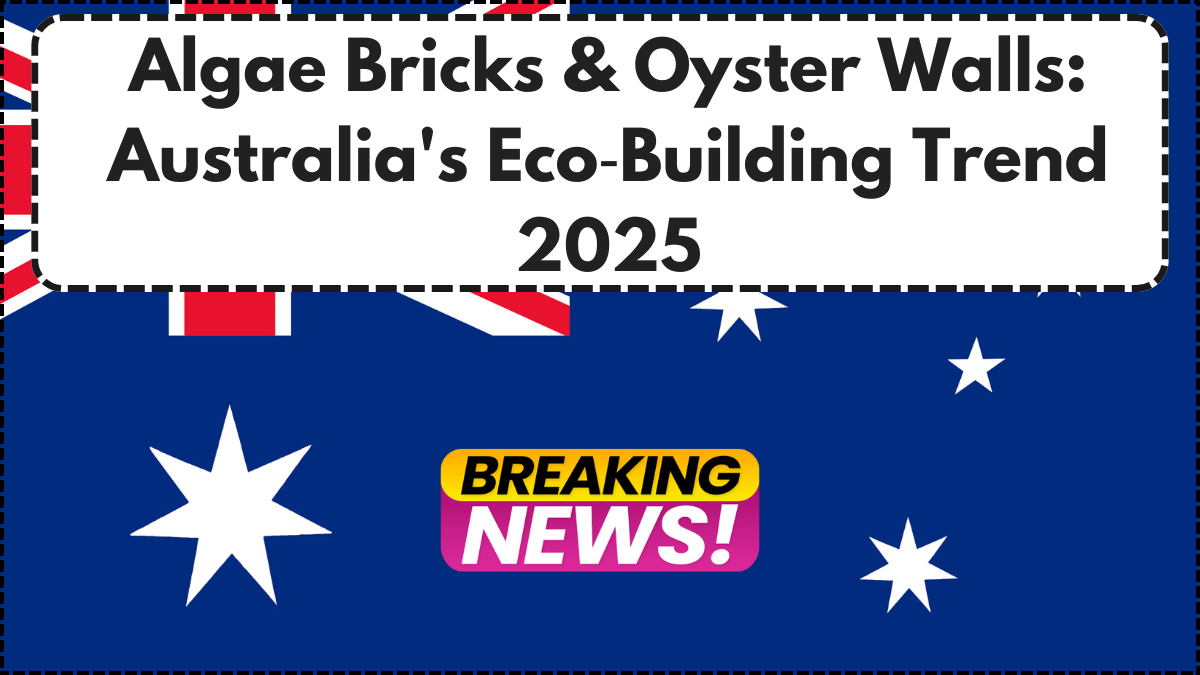Australia is shifting gears in its sustainable architecture journey, and July 2025 marks a pivotal moment. The rise of algae bricks and oyster walls AU 2025 is no longer an experimental concept—it’s a growing movement reshaping urban landscapes. Spearheaded by architects, marine scientists, and sustainability innovators, this trend merges the power of biomaterials with urgent environmental needs.

The Science Behind Algae Bricks
Algae bricks aren’t just green in color—they’re green in function. These bio-engineered bricks are made from microalgae combined with sand and a natural binding agent, forming a solid material with carbon-absorbing properties. In 2025, Australian startups are scaling up algae cultivation in urban vertical farms, feeding directly into eco-friendly building production. Unlike traditional concrete, algae bricks reduce emissions and store carbon, making them ideal for low-impact construction.
Research from the University of Sydney has shown that algae bricks can cut down embodied carbon in buildings by up to 60%. Their breathable composition also aids in regulating indoor air quality, adding another layer of environmental benefit. Builders across New South Wales and Victoria have already begun piloting algae brick façades on small residential developments.
Oyster Walls: Where Marine Waste Meets Structural Innovation
The concept of oyster walls takes marine waste and gives it purpose. Crushed oyster shells—once discarded by the seafood industry—are now being transformed into building blocks with remarkable durability. The shells are cleaned, ground, and bonded using low-impact cement alternatives. These walls are naturally resistant to erosion, ideal for Australia’s coastal architecture prone to harsh weather conditions.
In places like Brisbane and Fremantle, architects are incorporating oyster wall systems into flood-resilient homes and civic buildings. Oyster shells also contribute calcium carbonate, strengthening the structure and reducing reliance on high-emission materials. What was once a waste problem is now a core solution in Australia’s eco-building toolkit.
Why Biomaterial Innovation is Critical in 2025
As of July 2025, construction emissions still account for nearly 39% of Australia’s total carbon footprint. With government targets pushing for net-zero by 2040, biomaterial innovation is more than a buzzword—it’s a lifeline. Algae bricks and oyster walls AU 2025 align with these goals by offering circular, renewable alternatives to legacy materials.
Federal and state incentives are accelerating adoption. Grants for eco-friendly building initiatives and fast-tracked permits for biomaterial-based projects are now in effect. Industry leaders are also collaborating with universities to develop standardized testing protocols, ensuring these materials meet safety codes and scalability standards.
Practical Applications and Future Outlook
From sustainable schools in Adelaide to eco-retail hubs in Melbourne, algae bricks and oyster walls are proving their versatility. The trend is expanding beyond prototypes into mass production, with modular design systems making it easier for builders to integrate these materials into diverse structures.
Here’s a quick overview of how these biomaterials compare with traditional building materials:
| Feature | Algae Bricks | Oyster Walls | Traditional Concrete |
|---|---|---|---|
| Carbon Emissions | Negative (carbon-sequestering) | Low (made from waste) | High |
| Source Material | Algae biomass + sand | Crushed oyster shells | Cement + gravel |
| Durability | Moderate | High (salt-resistant) | High |
| Cost (2025) | Moderate (dropping) | Moderate | Low to moderate |
| Environmental Impact | Very Low | Very Low | Very High |
Looking ahead, major construction firms like BuildGreen AU and EcoMatter Projects are preparing to adopt these materials at scale, aiming to retrofit older buildings with algae facades and oyster-based insulation. This shift could redefine urban design standards across the country.
Conclusion: Australia’s Eco Architecture Revolution is Underway
In July 2025, Australia stands at the edge of an eco-building revolution. Algae bricks and oyster walls AU 2025 offer more than environmental benefits—they represent a cultural shift toward valuing sustainable innovation. As these technologies mature, expect to see them move from niche projects into mainstream cityscapes, setting new benchmarks for building responsibly in a warming world.
FAQs
What are algae bricks made from?
Algae bricks are created using microalgae, sand, and natural binders. They are engineered to absorb carbon and provide structural integrity.
How do oyster walls help the environment?
Oyster walls repurpose marine waste into durable building materials, reducing landfill impact and cutting down on the need for high-emission materials.
Are these materials safe for large buildings?
Yes, ongoing testing and certifications in Australia are ensuring algae bricks and oyster walls meet safety standards for various building sizes.
Can homeowners use these materials?
Absolutely. In 2025, smaller-scale residential projects are already integrating algae bricks and oyster walls with growing support from eco-friendly building incentives.
Is this trend limited to coastal areas?
While oyster walls are especially useful near the coast, algae bricks can be used anywhere in Australia, from urban to rural developments.
Click here to learn more
Akesh is a talented content writer known for creating captivating and impactful narratives. He understands what resonates with audiences and tailors his content to inform, inspire, and engage. From blog posts and articles to marketing copy, his work consistently combines creativity with clarity. His skillful writing strengthens our brand’s voice and ensures our message leaves a meaningful impression.



